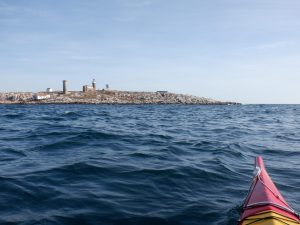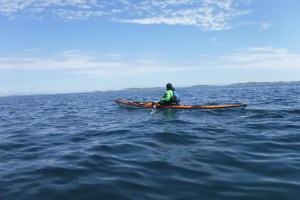Paddling Long & Far: Reflections on Offshore & Long-Distance Paddling

An Interview with Sea Kayak Guides Joe Guglielmetti & Kyle Martin
This winter we’re posting a series of interviews with Portland Paddle guides, each one focused on a specific topic related to paddling the Maine coast. Today we’re sharing a conversation with longtime guides Joe Gugliemetti and Kyle Martin about two “extreme” forms of kayaking: Very long-distance expeditions and paddling very far from shore. Conversations have been edited for length and clarity.
Q: What advice would you have for someone who is planning their first long distance paddle?
Joe: Focus on hours in the boat instead of time to go a certain distance. Say, “I’m going to be in my boat for 7 hours today.” Instead of “I’m going to paddle 20 miles in 5 hours today.” The hours don’t have to be consecutive, just total for the day. So you could say, three hours in a morning session, and four in an evening session. And for off-water training, core, core, core!
Kyle: You want to try and work up to a longer distance. The times I have been most successful with distance paddling has been when I’ve paddled a similar length route relatively recently, so I know that I’m just pushing it a little further and the muscle memory is built up. Also use an activity tracking app like Strava that will tell you how far you have gone so you can compare for your next paddle. Another major piece of advice for anyone setting out on a long paddle is to make sure you have plenty to drink and eat while you are paddling. This will make a monumental difference. An electrolyte drink mix is key for me. On such a long paddle, you’re likely going to get frazzled and burnt-out from the sun and spray, and sometimes just swallowing some bites of food and water can be a good reset in your brain. Your body will also thank you.
Q: What skills and equipment does someone need to have for their first offshore paddle?
Kyle: You will never catch me offshore without a handheld marine airhorn and a VHF radio. The airhorn is very effective when used in a marine setting, as sounding it with multiple short blasts implies collision imminent so it is a real way to get the attention of boats that are bigger than you or you think may not see you. The VHF is also key for announcing your crossing of a busy channel, monitoring the traffic of other vessels, and communicating with other boats around you. I also like to carry a PLB, or personal locator beacon, that I paddle with in my vest. This gives a nice peace of mind as a redundant form of emergency communication when far from shore. SPOT Finder is the one I use, and it can be used to communicate with friends and loved ones back on land, and as a distance tracker.
Finally, it’s not really a safety thing, but especially for distance paddling I find a wing paddle is nice as it relieves the need to direct the face of the paddle through the water. With proper technique, a wing paddle will do this for you and save you a lot of energy. The one I prefer is the Epic Kayaks Mid-wing.
Q: Why should someone try out more extreme paddling? What do you like about these bigger adventures?
Joe: Distance paddling allows a clear path to growth and improvement with tangible goals and results.
Kyle: The excitement and challenge it presents. To me it really feels like elevating your paddling to the next level when you venture further from shore and can still feel comfortable. I also love how it elevates your senses in the now. On a long open water paddle, your mind is forced to only think about what is in front of you and making the next waypoint nothing else, so it’s a nice escape from your brain’s usual thought process.
Q: Could you share a favorite memory from an “extreme” paddle? What’s the farthest you’ve ever paddled in one day?
Joe: Solo: 68 miles. Tandem: 71 miles.
Kyle: One of my favorite memories of a distance paddle was the circumnavigation of Vinalhaven from Rockland in a single day with my friend Vytas. Total mileage for this trip totaled just over 40. We had planned to camp on some small islands just off of Vinalhaven but having arrived there at a relatively early hour in the day and having a great time paddling, we elected to paddle back to Rockland. Admittedly the last several miles of that paddle were harrowing, and making a big change in plans like that isn’t usually a good idea. But we were confident in our abilities, and knew the tidal currents would allow it to happen. A small lightning system rolled in on us as we crossed Lermond Cove (Rockland Harbor). It was completely dark at this point as we had made the big crossing from Vinalhaven to Owls Head just as the sun had set. We were tired and sore and got somewhat lost in the dark, but we finally spotted the boat ramp of the Atlantic Challenge which seemed to illuminate itself just for us.
Q: What was your first paddle that felt really “big” to you?
Joe: Paddling from the mainland to Mount Desert Rock and back.
Q: How did you start doing more “extreme” paddles? What inspired you?
Kyle: I was and still am really inspired by endurance paddlers like Freya Hoffmeister and Andrew McAuley. Both have excellent books worth reading. From there I found out about people like Greg Barton and Oscar Chalupsky and that is how I developed much of my foreword stroke paddling style. I learned a lot from their instructional DVD, The Kayak Foreword Stroke.
After graduating college, I paddled a lot on the lower sections of the St. George River and this was excellent training for longer paddles, as being on a tidal river you don’t need to worry about the exposure to wind and waves you’d experience on the open ocean, so you’re able to focus on just moving. I am very fortunate in that my childhood home is adjacent to the river so a common paddle for me would be to leave from my parents’ home in Thomaston at high tide, paddle to Port Clyde to the general store for a substantial breakfast, and then back up the river. I think this is where I developed a lot of my confidence for longer paddles.
Q: Could you share some of your favorite memories or destinations for offshore paddling?
Kyle: One of my favorite destinations is Stonington. The concentration of small islands and diverse options for route selection make this an ideal paddling area for me. It’s nice when guiding too, as there are so many options you have a huge range of choices to tailor a trip for a group. Wheat island which can be found just outside of Stonington is one of my favorite islands to camp at. With its immediate vicinity to Isle Au Haut allowing for the option of a circumnavigation the following day after arrival. There are plenty of options for big, open water here too, with crossing to the Fox Island Thoroughfare, or towards Marshall and Swan island. I have cultivated some lasting paddling memories here and look forward to returning every year.
Q: Any other thoughts you would like to share?
Kyle: Distance paddling and paddling in general can be an excellent way to get outside and connect with people. I’ve experienced some of the most incredible and remote places along the coast of Maine with the most amazing people because of kayaking. I would encourage anyone looking for a similar experience to get out on the water and look for ways to get involved, be it through paddling with clubs such as SMSKN or NSPN, or taking an instructional course, all of which have been integral parts of my paddling career.
Thanks to Kyle and Joe for sharing their experience with us! If you want to hear more from Joe, check out the talks he did for the Maine Island Trail Association on his speed record of the coast, and for SMSKN on his crossing of the Bay of Fundy. If you’re interested in dipping your toes into the world of longer paddles, consider joining one of our full day or multi-day tours, or start building your independent paddling skills with a weekend skills workshop.



